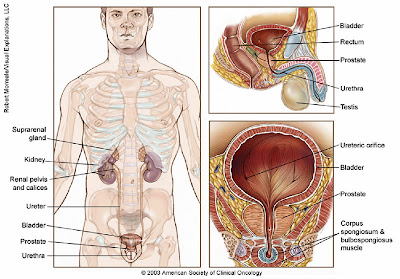Carcinoid Cancer Biography
Source(google.com.pk)
Carcinoid syndrome is caused by carcinoid tumors, which are small slowly growing tumors of enterochromaffin cells. Carcinoids display a spectrum of aggressiveness with no clear distinguishing line between benign and malignant. The majority of carcinoid tumors do not cause significant clinical disease. Those tumors that behave more aggressively tend to cause nonspecific GI disturbances, such as intermittent pain and bloating, for many years before more overt symptoms develop.
Approximately 85% of carcinoid tumors are located in the GI tract, 10% in the lung, and 5% in various other sites including thymus, ovary, kidney, prostate, skin, and breast. The GI tract carcinoid tumors are subdivided into:
Foregut carcinoids, arising from respiratory tract, stomach, pancreas or duodenum (15% of cases)
Midgut carcinoids, occurring within jejunum, ileum, or appendix (70% of cases)
Hindgut carcinoids, which are found in the colon or rectum (15% of cases)
The carcinoid syndrome consists of flushing, diarrhea, bronchoconstriction, wheezing, right heart valve disease, and fibrosis of endocardium, blood vessels, and skin. It is usually caused by midgut tumors, because foregut and hindgut neoplasms produce far lesser amounts of serotonin. Since midgut tumors drain into the portal circulation, which passes into the liver, symptoms do not usually occur until the tumor metastasizes to the liver and releases humoral factors directly into the systemic circulation.
The laboratory diagnosis of carcinoid syndrome relies on measurement of serum serotonin, urinary 5-hydroxyindoleacetic acid and serum chromogranin A. In most cases, if none of these 3 analytes is elevated, carcinoids can be excluded as a cause of symptoms suggestive of carcinoid syndrome.
Serotonin (5-hydroxytryptamine; 5-HT) is synthesized from the essential amino acid tryptophan. Once secreted, in concert with other gut hormones, 5-HT increases GI blood flow, motility, and fluid secretion. On first pass through the liver, between 30 and 80% of 5-HT is metabolized, predominately to 5-hydroxyindoleacetic acid (5-HIAA), which is water soluble and excreted by the kidneys. Ninety-percent of the remainder is metabolized in the lungs, also to 5-HIAA. Of the remaining 10%, almost all is taken up by platelets, where it remains until it is released during clotting, promoting further platelet aggregation.
In a symptomatic patient, a serum serotonin value of >400 ng/mL is suggestive of a carcinoid tumor. Metastatic carcinoid tumors show very high levels of serum serotonin, usually exceeding 1000 ng/mL. Serotonin production by disseminated carcinoid tumors can sometimes be so substantial that body tryptophan stores become depleted and clinical tryptophan deficiency, resembling pellagra (triad of diarrhea, dementia, and dermatitis), develops.
In patients with more advanced tumors, circulating 5-HT is elevated in nearly all patients with midgut tumors, but only in approximately 50% of those with foregut carcinoids, and 20% of individuals with hindgut tumors
Urinary 5-HIAA is elevated in almost all carcinoid-syndrome patients with midgut tumors, in about 30% of individuals with foregut carcinoids, but almost never in hindgut tumors.
5-HIAA levels usually exceed 15 mg per 24 hours. If two 24-hour urine collections during spells fail to reveal an increased 5 HIAA level, diagnosis of a functioning carcinoid is unlikely.
Chromogranin A is a protein which is found in secretory granules of endocrine and neuroendocrine tissues. Chromogranin A is almost always elevated in patients with symptomatic or metastatic carcinoid tumors. It is particularly valuable in diagnosing hindgut tumors because they usually do not secrete excessive amounts of serotonin and 5-HIAA.
Disease progression can be monitored in patients with serotonin-producing carcinoid tumors by measurement of 5-HT in blood. However, at levels above approximately 5,000 ng/mL, the serotonin storage capacity of platelets becomes limiting, and there is no longer a linear relationship between tumor burden and blood 5-HT levels. Urinary 5-HIAA and serum chromogranin A continue to increase in proportion to the tumor burden to much higher 5-HT production levels, and are therefore better suited for follow-up in patients with extensive disease.
Medications that may elevate serotonin concentrations include lithium, MAO-inhibitors, methyldopa, morphine, and reserpine. The observed levels are usually <400 ng/mL. Selective serotonin reuptake inhibitors (e.g., fluoxetine) can lead to depletion of platelet
serotonin levels and result in false-negative blood 5-HT tests. The effects of drugs are more marked on urinary 5-HIAA levels than on blood 5-HT levels.
Serotonin- or tryptophan-rich foods (avocados, bananas, plums, walnuts, pineapple, eggplant, plantain, tomatoes, hickory nuts, kiwi, dates, grapefruit, cantaloupe, and honeydew melon) do not contribute significantly to blood 5-HT measurements, but can elevate urinary 5-HT and urinary 5-HIAA levels up to 10-fold. They should be avoided for 48 hours prior to the start of the collection.
Since most circulating 5-HT is contained in platelets, the preferred specimens for measurement either include all or most of the platelets, such as whole blood or serum from completely clotted specimens. Clotting releases most of the 5-HT from platelets.
Carcinoid CancerSign Ribbon cells Horoscope Symbol Tattoos Research Zodiac Sign Ribbon Tattoos
 |
Carcinoid CancerSign Ribbon cells Horoscope Symbol Tattoos Research Zodiac Sign Ribbon Tattoos
|
 |
Carcinoid CancerSign Ribbon cells Horoscope Symbol Tattoos Research Zodiac Sign Ribbon Tattoos
|
 |
Carcinoid CancerSign Ribbon cells Horoscope Symbol Tattoos Research Zodiac Sign Ribbon Tattoos
|
 |
Carcinoid CancerSign Ribbon cells Horoscope Symbol Tattoos Research Zodiac Sign Ribbon Tattoos
|
 |
Carcinoid CancerSign Ribbon cells Horoscope Symbol Tattoos Research Zodiac Sign Ribbon Tattoos
|
 |
Carcinoid CancerSign Ribbon cells Horoscope Symbol Tattoos Research Zodiac Sign Ribbon Tattoos
|
 |
Carcinoid CancerSign Ribbon cells Horoscope Symbol Tattoos Research Zodiac Sign Ribbon Tattoos
|
 |
Carcinoid CancerSign Ribbon cells Horoscope Symbol Tattoos Research Zodiac Sign Ribbon Tattoos
|
 |
Carcinoid CancerSign Ribbon cells Horoscope Symbol Tattoos Research Zodiac Sign Ribbon Tattoos
|
 |
Carcinoid CancerSign Ribbon cells Horoscope Symbol Tattoos Research Zodiac Sign Ribbon Tattoos
|




































